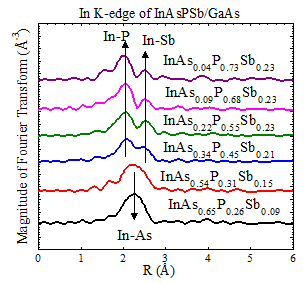 |
X-ray absorption fine structure of InAsPSb grown by gas-source molecular-beam epitaxy
Professor
Hao-Hsiung Lin's
Laboratory
Graduate Institute of Photonics and
Optoelectronics, National Taiwan University
臺灣大學光電所 林浩雄教授
We have
investigated the atomic
structure of InAsPSb, a
mid-infrared alloy consisting of
binaries with highly mismatch
bond lengths, using P K-edge and
In K-edge extended X-ray
absorption fine structure
(EXAFS). The alloy
with wide composition range,
grown by gas-source
molecular-beam epitaxy, were
measured, in collaboration with
Prof. Zhe-Chuan Feng, at
National Synchrotron Radiation
Research Center. The InP bond
length determined from the P
K-edge EXAFS, shown in Fig. 1,
is virtually independent of
alloy composition and lattice
constant, which is in conflict
with the virtual crystal
approximation and Vegard’s law
and is very close to Pauling’s
model. The In K-edge EXAFS,
consisting of signals from InP,
InAs, and InSb bonds, is shown
in Fig. 2. For the samples with
low As composition, two separate
peaks representing InP and InSb
bonds are evident. When the As
composition increases, the peaks
gradually merge into the rising
InAs signal. We used a model
based on valence force field
(VFF) theory to fit the EXAFS.
The result shows that with the
increase of As mole fraction,
the dominant In-centered basic
unit cell in the alloys changes
from cell with 2 P and 2 Sb to
cell with 4 As and finally to
cell with 2 As, 1 P, and 1 Sb.
VFF calculation indicates that
cell with 2 P and 2 Sb has
higher bond distortion energy
than the other two cells, which
explains the immiscibility
behavior we observed in previous
studies.
|
 |
 |
|
Fig. 1 Fourier
transformed P K-edge EXAFS signal of the
InAsPSb. The InP bond length of the
samples is virtually fixed. |
Fig. 2
Fourier transformed
In K-edge EXAFS signal of the InAsPSb. |
|
 |